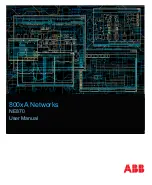
32
Configuring Interfaces
Configuring Ethernet Interfaces
Default Ethernet Interface Configuration
shows the Ethernet interface default configuration for NNIs, and
shows the
Ethernet interface default configuration for UNIs and ENIs. For more details on the VLAN parameters listed in the table,
see
Note:
To configure Layer 2 parameters, if the interface is in Layer 3 mode, you must enter the
switchport
interface
configuration command without any parameters to put the interface into Layer 2 mode. This shuts down the interface
and then re-enables it, which might generate messages on the device to which the interface is connected. When you
put an interface that is in Layer 3 mode into Layer 2 mode, the previous configuration information related to the affected
interface might be lost, and the interface is returned to its default configuration.
Table 6
Default Ethernet Configuration for NNIs
Feature
Default Setting
Operating mode
Layer 2 or
switching mode (
switchport
command).
Allowed VLAN range
VLANs 1– 4094.
Default VLAN (for access ports)
VLAN 1 (Layer 2 interfaces only).
Native VLAN (for 802.1Q trunks)
VLAN 1 (Layer 2 interfaces only).
VLAN trunking
Switchport mode access (Layer 2 interfaces only).
Port enable state
Enabled.
Port description
None defined.
Speed
Autonegotiate.
Duplex mode
Full.
802.3x flow control
Flow control is set to
receive
:
off
. It is always off for sent packets.
EtherChannel
Disabled on all Ethernet ports. See
Port blocking (unknown multicast and unknown
unicast traffic)
Disabled (not blocked) (only Layer 2 interfaces).
Broadcast, multicast, and unicast storm control
Disabled.
Port security
Disabled (only Layer 2 interfaces).
Port Fast
Disabled.
Auto-MDIX
Enabled.
Note:
The switch might not support a pre-standard powered
device—such as Cisco IP phones and access points that do not fully
support 802.3af/802.3at—if that powered device is connected to the
switch through a crossover cable. This is regardless of whether
auto-MIDX is enabled on the switch port.
Power over Ethernet (PoE)
Enabled (auto).
Cisco Discovery Protocol (CDP)
Enabled.
VMPS
Not configured.
Summary of Contents for IE 4000
Page 12: ...8 Configuration Overview Default Settings After Initial Switch Configuration ...
Page 52: ...48 Configuring Interfaces Monitoring and Maintaining the Interfaces ...
Page 108: ...104 Configuring Switch Clusters Additional References ...
Page 128: ...124 Performing Switch Administration Additional References ...
Page 130: ...126 Configuring PTP ...
Page 140: ...136 Configuring CIP Additional References ...
Page 146: ...142 Configuring SDM Templates Configuration Examples for Configuring SDM Templates ...
Page 192: ...188 Configuring Switch Based Authentication Additional References ...
Page 244: ...240 Configuring IEEE 802 1x Port Based Authentication Additional References ...
Page 298: ...294 Configuring VLANs Additional References ...
Page 336: ...332 Configuring STP Additional References ...
Page 408: ...404 Configuring DHCP Additional References ...
Page 450: ...446 Configuring IGMP Snooping and MVR Additional References ...
Page 490: ...486 Configuring SPAN and RSPAN Additional References ...
Page 502: ...498 Configuring Layer 2 NAT ...
Page 770: ...766 Configuring IPv6 MLD Snooping Related Documents ...
Page 930: ...926 Configuring IP Unicast Routing Related Documents ...
Page 976: ...972 Configuring Cisco IOS IP SLAs Operations Additional References ...
Page 978: ...974 Dying Gasp ...
Page 990: ...986 Configuring Enhanced Object Tracking Monitoring Enhanced Object Tracking ...
Page 994: ...990 Configuring MODBUS TCP Displaying MODBUS TCP Information ...
Page 996: ...992 Ethernet CFM ...
Page 1066: ...1062 Using an SD Card SD Card Alarms ...
















































